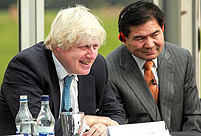Premier Li Keqiang met leaders from the Association of Southeast Asian Nations on Wednesday and urged the two sides to start establishing an "upgraded version" of the China-ASEAN Free Trade Area.
Based on booming bilateral business in the past 10 years, promoting trade in goods and services, increasing investment cooperation and advancing trade and investment liberalization and facilitation are among the measures driving relations between the two sides.
The premier said China will strive to increase the bilateral trade volume to $1 trillion by 2020. Meanwhile, mutual investment is expected to hit $150 billion in the coming eight years.
"China and ASEAN should strive for extensive, deep and high-level cooperation in the upcoming decade," Li said in a speech at the meeting. And the proposed upgraded China-ASEAN Free Trade Area is one important part of boosting cooperation between the two sides.
This year also marks the 10th anniversary of the establishment of the China-ASEAN strategic partnership, with bilateral trade witnessing a significant increase.
China is now ASEAN's largest trading partner, while ASEAN ranks as China's third-largest trading partner.
Trade value between China and ASEAN reached $400.1 billion last year, nearly six times the level 10 years ago. In the first half of 2013, the figure was $210.56 billion, a year-on-year increase of 12.2 percent.
Experts said upgrading the China-ASEAN Free Trade Area requires building an area for closer, freer and comprehensive economic and trade cooperation.
"The agreement shows the region closely relies on China's economic vitality on the basis of the two sides properly responding to the international financial crisis," said Liu Jiangyong, a professor of international relations at Tsinghua University.
Liu said cooperation, for example on lowering tariffs and providing more convenient logistics, will increase bilateral trade and people-to-people exchanges.
"The more open and inclusive integration will provide new opportunities for ASEAN economies and push forward China's economy, especially driving development in southwest China," Liu said.
But, as the world's second-largest economy, China's direct investment in ASEAN is lagging. By the end of June, its direct investment in the regional bloc was nearly $30 billion, while direct investment from ASEAN into China exceeded $80 billion.
Zhang Yunling, a researcher from the Chinese Academy of Social Sciences, said: "In the past decade, bilateral trade in goods has seen a breakthrough. The further evolution of bilateral relations exists in extending a more comprehensive partnership, such as more service trade cooperation and opening up investment.
"The upgraded version of the China-ASEAN Free Trade Area will bring some changes in the bilateral trade structure because the volume of service trade will be underlined."
Premier Li proposed an upgraded version of the free trade area at the opening ceremony of the 10th China-ASEAN Expo and the China-ASEAN Business and Investment Summit in Nanning in September.
 2013 Colour Me Rad 5K run held in Canada
2013 Colour Me Rad 5K run held in Canada China's destroyer Qingdao sails out of Sydney Harbor
China's destroyer Qingdao sails out of Sydney Harbor Chinese tycoon aims to restore London's Crystal Palace
Chinese tycoon aims to restore London's Crystal Palace Typhoon Fitow affects 4.56 million people in east China
Typhoon Fitow affects 4.56 million people in east China Game for the brave: 'Spiders' in Yandang Mountains
Game for the brave: 'Spiders' in Yandang Mountains Travel peak witnessed on last day of National Day holiday
Travel peak witnessed on last day of National Day holiday  New couples take wedding photos during holiday
New couples take wedding photos during holiday Serena Williams stumbles through to quarterfinals
Serena Williams stumbles through to quarterfinals Thailand Mobile Expo 2013 kicks off
Thailand Mobile Expo 2013 kicks off Photo collection of Chinese Navy
Photo collection of Chinese Navy Dense haze envelops N China
Dense haze envelops N China Twins Culture Festival kicks off in Beijing
Twins Culture Festival kicks off in Beijing UNESCO world heritage site: Montale Tower
UNESCO world heritage site: Montale Tower Israeli drone crashes into Mediterranean, fragments recovered
Israeli drone crashes into Mediterranean, fragments recovered Serena Williams wins second China Open title
Serena Williams wins second China Open titleDay|Week|Month